Keywords:OpenAI, AI regulation, large language models, AI ethics, AI innovation, AI power concentration, AI Safety Act, AI governance, OpenAI legal threats, GTAlign alignment framework, ARES multimodal reasoning, xAI world model, SAM 3.0 segmentation technology
🔥 Spotlight
主题: OpenAI Accused of Intimidating Nonprofit: During the deliberation of California’s AI safety bill, OpenAI was reportedly found to have issued a subpoena to Encode, a nonprofit with only three employees, demanding all records and private communications, and baselessly accusing it of being funded by Elon Musk. Encode publicly condemned this action as legal intimidation, aimed at suppressing criticism of OpenAI’s policy positions. The incident drew criticism from OpenAI’s internal employees and former board members, highlighting the aggressive tactics employed by large AI companies in the face of regulation, and the challenges faced by small advocacy groups against giants, even though the SB 53 bill ultimately passed, requiring AI companies to submit risk assessments and transparency reports (Source: Reddit r/ArtificialInteligence)
主题: Nobel Economist Warns: Concentrated AI Power Could Stifle Innovation: Philip Aghion, one of this year’s Nobel laureates in economics, pointed out that the concentration of AI power in the hands of a few companies could hinder innovation and economic growth. He believes that innovation relies on competition, and a monopoly on AI resources could lead to stagnant progress, making it difficult for startups to challenge existing giants. This has sparked discussions about AI governance and regulatory forms to prevent AI from becoming a bottleneck to growth rather than a driver (Source: Reddit r/ArtificialInteligence)
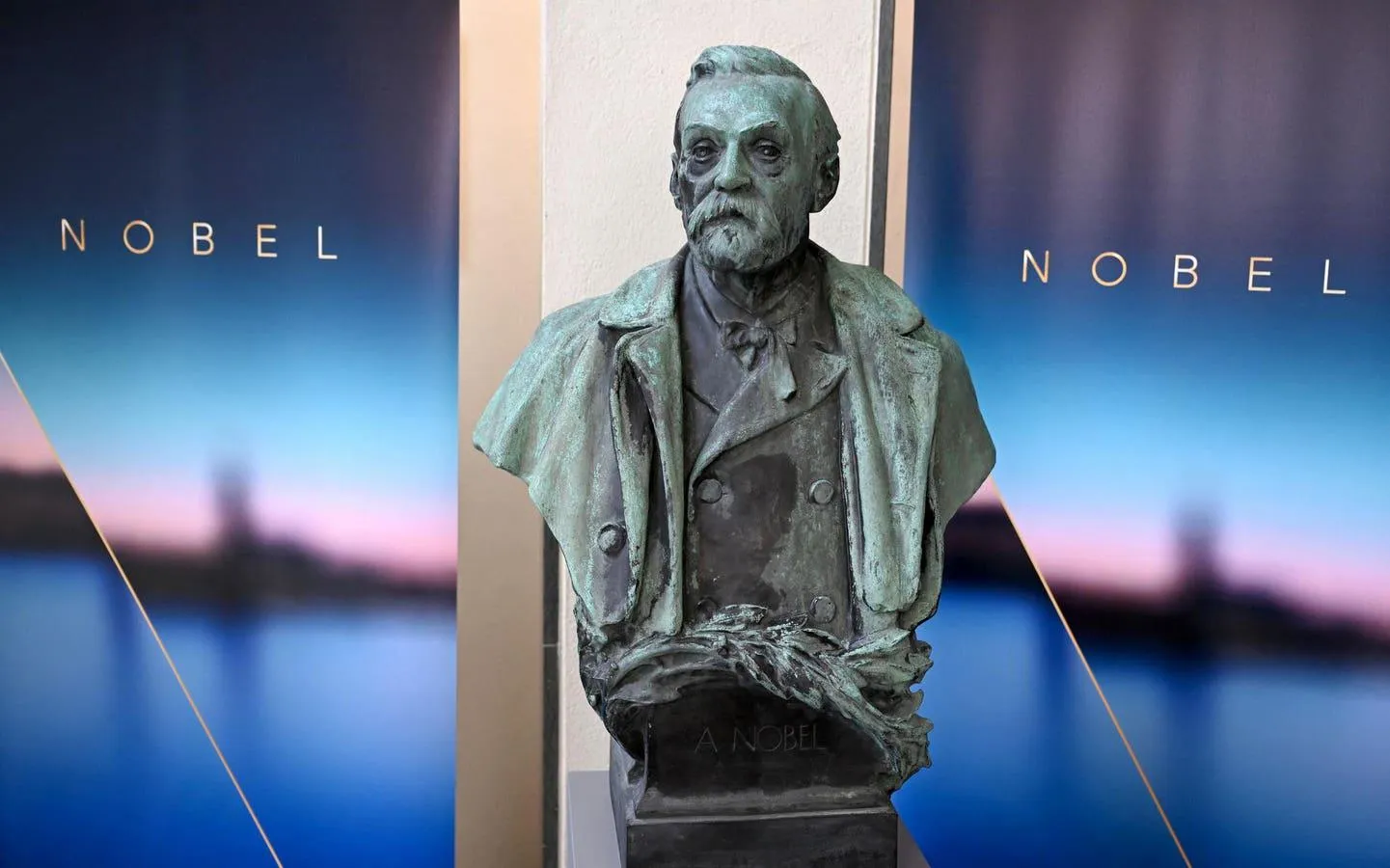
主题: GTAlign: A Game Theory-Based Alignment Framework for LLM Assistants: Researchers have proposed GTAlign, an alignment framework that integrates game-theoretic decision-making into LLM reasoning and training. This framework constructs a payoff matrix to evaluate the joint welfare of the LLM and the user, and selects mutually beneficial actions. During training, a reciprocal welfare reward is introduced to reinforce cooperative responses. Experiments show that GTAlign significantly improves LLM reasoning efficiency, answer quality, and joint welfare across diverse tasks, addressing issues where traditional alignment methods might lead to reduced user experience due to excessive verbosity (Source: HuggingFace Daily Papers)
主题: ARES: Multimodal Adaptive Reasoning via Difficulty-Aware Entropy Shaping: ARES is a unified open-source framework that addresses the efficiency imbalance of Multimodal Large Reasoning Models (MLRMs) when handling tasks of varying difficulty by dynamically allocating exploration effort. It uses window entropy to identify critical reasoning moments and employs a two-stage training process (adaptive cold start and adaptive entropy policy optimization) to enable the model to reduce overthinking on simple problems and increase exploration on complex ones. ARES demonstrates superior performance and reasoning efficiency across mathematical, logical, and multimodal benchmarks, significantly reducing inference costs (Source: HuggingFace Daily Papers)
🎯 Trends
主题: Elon Musk’s xAI Enters World Model Arena, Poaches NVIDIA Talent for AI Gaming: xAI is actively venturing into the world model domain, recruiting several senior researchers from NVIDIA, with plans to release an AI-generated, world model-driven game by the end of 2026. xAI’s goal is for AI to understand the nature of the universe, applying world models to AI games, agents, autonomous driving, and embodied AI robots, aiming to build a complete AI ecosystem (Source: 量子位)

主题: Meta’s “Segment Anything” 3.0 Revealed: SAM 3.0 introduces Promptable Concept Segmentation (PCS), supporting multi-instance segmentation tasks based on phrases or image examples. The new architecture design includes a DETR-based detector and a Presence Head module, decoupling object recognition from localization to improve detection accuracy. Through a large-scale data engine and the SA-Co benchmark, SAM 3.0 achieves new SOTA results in open-vocabulary segmentation tasks and can be combined with multimodal large models to solve complex reasoning segmentation tasks (Source: 量子位)
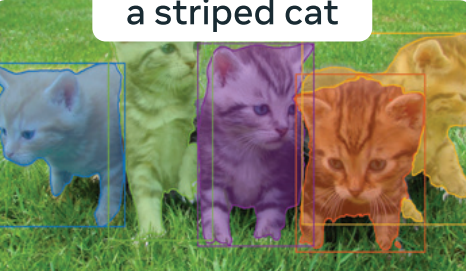
主题: Baidu World 2025 Scheduled, Focusing on AI Applications and Large Model Ecosystem: Baidu announced that Baidu World 2025 will be held on November 13 in Beijing, with the theme “Effect Emergence | AI in Action.” The conference will comprehensively showcase Baidu’s latest advancements in AI applications, large models, AI ecosystem, and globalization, including Wenxin iRAG, no-code Miaoda, digital human technology, and the global expansion of autonomous driving “Apollo Go.” The conference will also offer over 40 AI open classes to empower AI application development (Source: 量子位)

主题: Reflection AI: “American DeepSeek” Valued at $8 Billion Before Product Launch: Reflection AI’s valuation has soared to $8 billion, securing $2 billion in funding from Nvidia, Sequoia Capital, and others, all before releasing an official product. Founded by former Google DeepMind core members, the company aims to be the “DeepSeek of the West,” offering high-performance MoE models through an “open-weight” approach, filling the Western market’s demand for non-Chinese open-source models, and targeting large enterprises and sovereign AI markets (Source: 36氪)

主题: Dolphin X1 8B Model Released: Llama3.1 8B Decensored Fine-tune: Dolphin X1 8B is now available on Hugging Face, a fine-tuned version of Llama3.1 8B Instruct, designed to maximally remove model censorship restrictions without compromising other capabilities. The model uses SFT+RL training, with benchmark results comparable to or higher than Llama3.1 8B Instruct. GGUF, FP8, and exl2 versions have been released with sponsorship from Deepinfra (Source: Reddit r/LocalLLaMA)
主题: Open-Source RAG Routes Diversifying: MiniRAG, Agent-UniRAG, SymbioticRAG, and other open-source RAG (Retrieval-Augmented Generation) solutions are diverging, presenting different design philosophies. MiniRAG aims for lightweight and local operation, Agent-UniRAG integrates retrieval and reasoning into a continuous agent pipeline, SymbioticRAG emphasizes human-AI collaboration and feedback learning, while toolkits like LangChain offer modular components. Users need to weigh accuracy, speed, and controllability when choosing, and pay attention to common issues like hallucinations and context loss (Source: Reddit r/LocalLLaMA)
主题: LLM4Cell: A Survey of Large Language Models and Agent Models in Single-Cell Biology: LLM4Cell provides the first unified survey of 58 foundation and agent models applied to single-cell research, covering RNA, ATAC, multi-omics, and spatial modalities. The study categorizes these methods into five major groups and maps them to eight key analytical tasks. By analyzing over 40 public datasets, it evaluates model applicability, data diversity, ethics, and scalability, and identifies challenges in interpretability, standardization, and trustworthy model development (Source: HuggingFace Daily Papers)
主题: KORMo: Korean Open Reasoning Model for Everyone: KORMo-10B is the first Korean-English bilingual large language model primarily trained on synthetic data. The model has 10.8B parameters, with 68.74% of the Korean portion being synthetic data. Experiments demonstrate that carefully curated synthetic data does not lead to instability or performance degradation in large-scale pre-training, and the model performs comparably to existing open-source multilingual models on reasoning, knowledge, and instruction-following benchmarks. The project fully open-sources its data, code, and training scheme, providing a transparent framework for synthetic data-driven open model development in low-resource settings (Source: HuggingFace Daily Papers)
主题: UML: Enhancing Unimodal Models with Unpaired Multimodal Data: UML (Unpaired Multimodal Learner) is a novel modality-agnostic training paradigm where models alternately process inputs from different modalities and share parameters, leveraging cross-modal structures to enhance unimodal representation learning without requiring explicitly paired datasets. Both theoretical and experimental results show that using unpaired data from auxiliary modalities (e.g., text, audio, images) consistently improves performance on downstream unimodal tasks such such as image and audio (Source: HuggingFace Daily Papers)
主题: “The Illustrated Guide to AI Agents” New Book Announcement: Jay Alammar and Maarten Gr are co-authoring a new book, “The Illustrated Guide to AI Agents,” to be published by O’Reilly Media. The book will delve into core concepts for understanding and building AI agents, covering advanced topics such as tools, memory, code generation, reasoning, multimodality, RLVR/GRPO, aiming to be the most visually rich project in the AI agent field (Source: JayAlammar, MaartenGr)
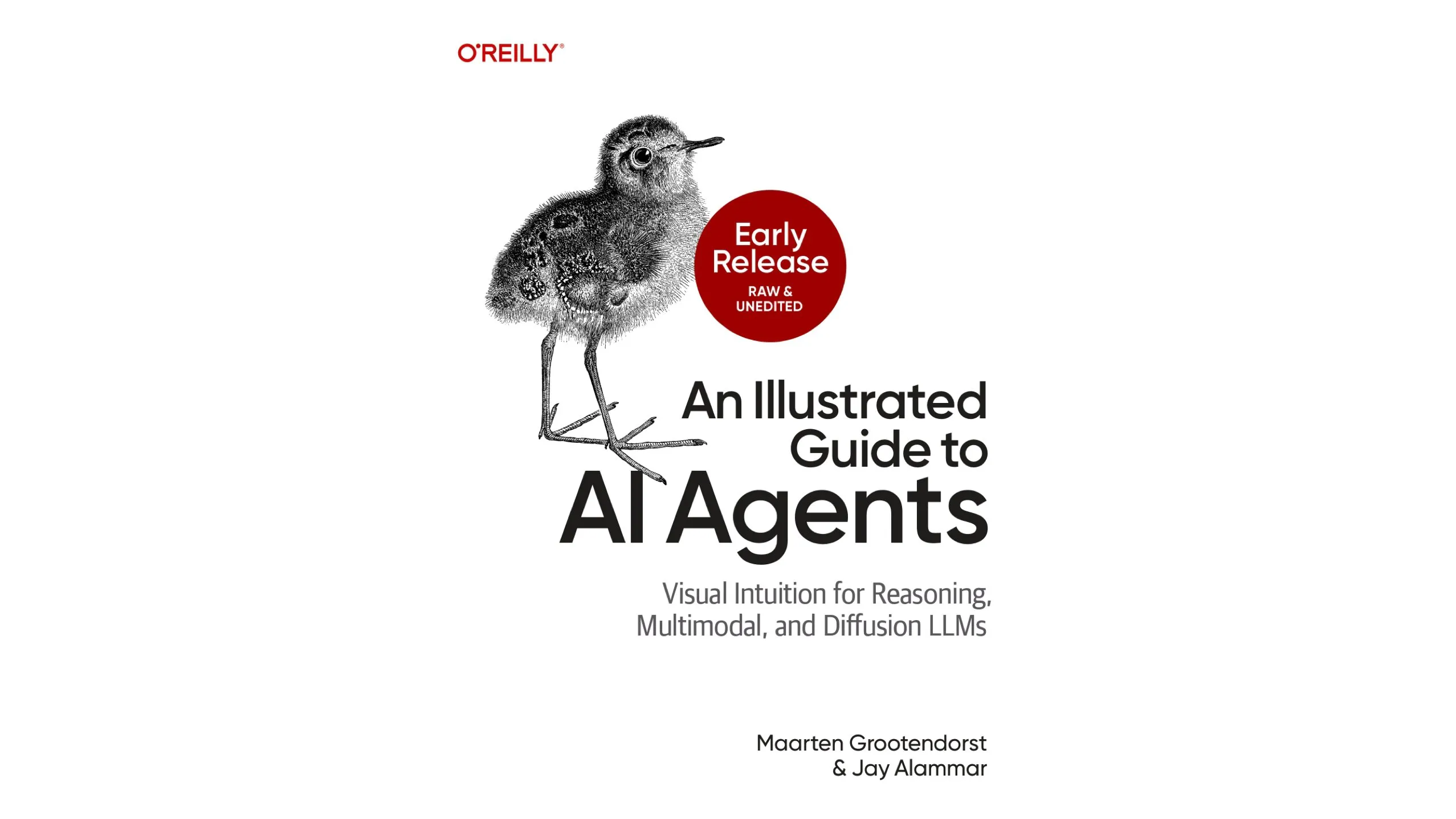
主题: SEAL: Self-Adapting Language Models for Continual Learning: New research titled SEAL (Self-Adapting Language Models) describes how AI models can continually learn after deployment, evolving their internal representations without retraining. The SEAL architecture enables models to learn from new data in real-time, self-repair degraded knowledge, and form persistent “memories” across sessions. If GPT-6 integrates this technology, it would achieve continually self-learning AI, moving beyond the era of “frozen weights” (Source: yoheinakajima)
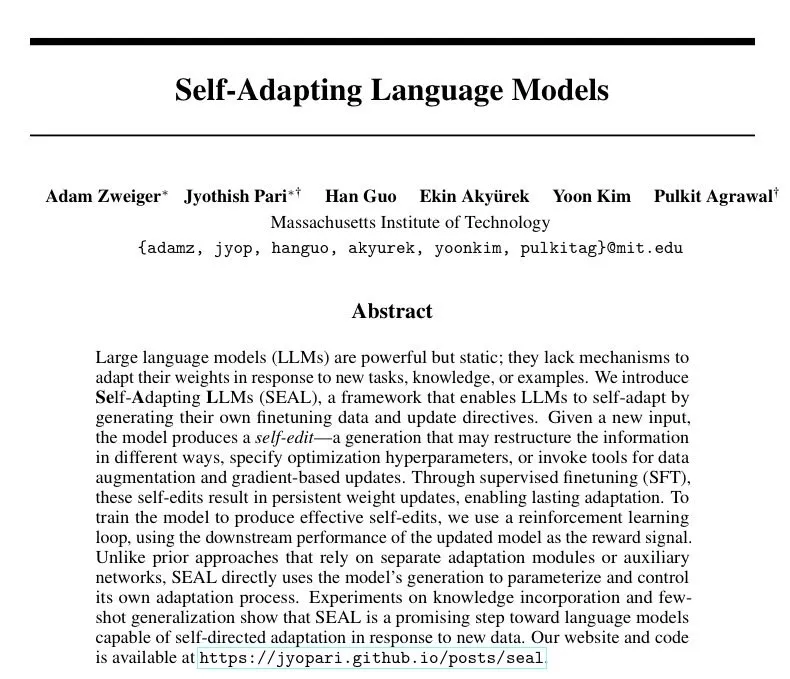
主题: Tencent Hunyuan Team Proposes New RL Method for LLM Reasoning Without Human Annotation: Tencent Hunyuan’s reasoning and pre-training team has introduced a new Reinforcement Learning (RL) method that replaces traditional “next-token prediction” with RL-based “next-segment prediction,” enabling the expansion of LLM reasoning capabilities without human-annotated data. This method, through two RL tasks—Autoregressive Segment Reasoning (ASR) and Intermediate Segment Reasoning (MSR)—significantly improves model performance on multiple benchmarks in mathematics and logic, demonstrating that reasoning expansion does not equate to cost expansion (Source: ZhihuFrontier, ZhihuFrontier)

🧰 Tools
主题: OpenAlex MCP Server: A Custom OpenWebUI Tool for Scientific Research: A developer has created the OpenAlex MCP Server for scientific research within OpenWebUI. This service integrates the free OpenAlex scientific index, allowing users to filter research papers by date and citation count, addressing unmet needs of existing tools and easily integrating into OpenWebUI (Source: Reddit r/OpenWebUI)
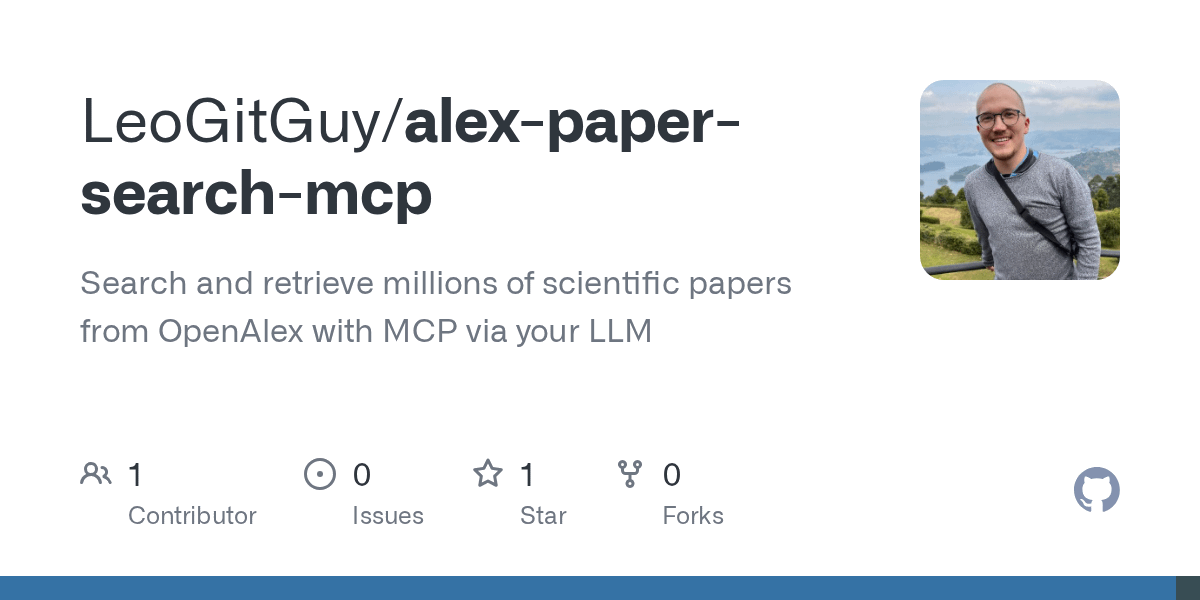
主题: Claude Successfully Diagnoses and Fixes User’s PC Performance Issue: A user shared how Claude AI helped them resolve a PC performance issue that had persisted for three years. Guided by Claude, the user discovered a hidden power performance setting deep within the control panel and adjusted it from “silent” mode to high-performance mode, boosting game frame rates from 16FPS to 60FPS. This demonstrates AI’s practical value in diagnosing and solving complex technical problems (Source: Reddit r/ClaudeAI)
主题: Microsoft Launches Copilot Benchmarks: Tracking Employee AI Usage Sparks Controversy: Microsoft has released a tool called Copilot Benchmarks, allowing managers to track how frequently employees use AI tools (like Copilot) in Office applications and compare usage with departmental averages and “top companies.” This move has raised concerns about workplace surveillance and data misuse, with many believing it could lead to AI usage becoming a basis for performance reviews or even layoffs, rather than genuine productivity enhancement (Source: Reddit r/ArtificialInteligence)
主题: MarkItDown: Microsoft Releases LLM Pipeline Document-to-Markdown Tool: Microsoft has launched MarkItDown, a Python tool that converts various file types such as PDF, Word, Excel, PowerPoint, HTML, CSV, JSON, XML, images, and audio into clean Markdown format. As Markdown is the “native language” for LLMs, this tool is ideal for preprocessing documents before feeding them into models, preserving headings, lists, tables, links, and metadata, thereby improving the efficiency and quality of LLM document processing (Source: TheTuringPost)
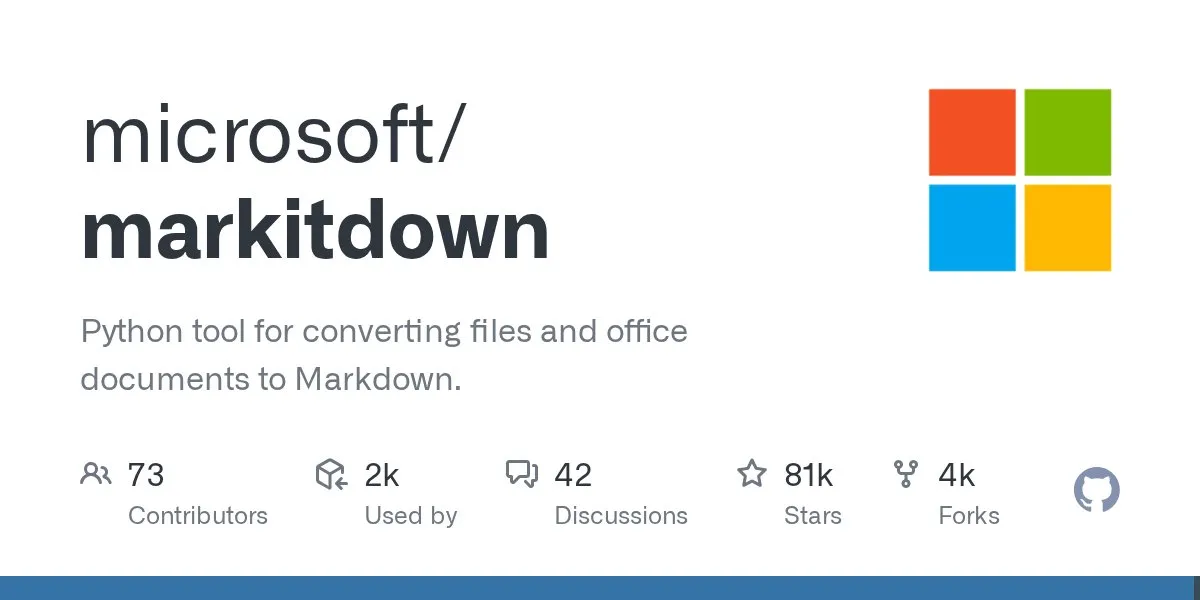
主题: vLLM Surpasses 60K GitHub Stars, Leading Efficient LLM Inference: The vLLM project has garnered 60,000 stars on GitHub, becoming a significant force in the LLM inference domain. It supports various hardware including NVIDIA, AMD, Intel, Apple, and TPU, and is compatible with mainstream text generation models like Llama, GPT-OSS, Qwen, DeepSeek, as well as RL pipelines like TRL and Unsloth. It is committed to providing efficient, scalable open LLM inference solutions, fostering the development of the AI ecosystem (Source: vllm_project)

主题: AgentFlow: Trainable Agent System for LLM-Driven Program Evolution: AgentFlow is an open-source trainable agent system where agents learn to plan and use tools through team collaboration within task flows. The system directly optimizes its Planner agent using the Flow-GRPO method. On multiple benchmarks including search, agent, mathematics, and science, AgentFlow (7B model) outperforms larger models like Llama-3.1-405B and GPT-4o, demonstrating the immense potential of LLMs in tool usage (Source: NerdyRodent)
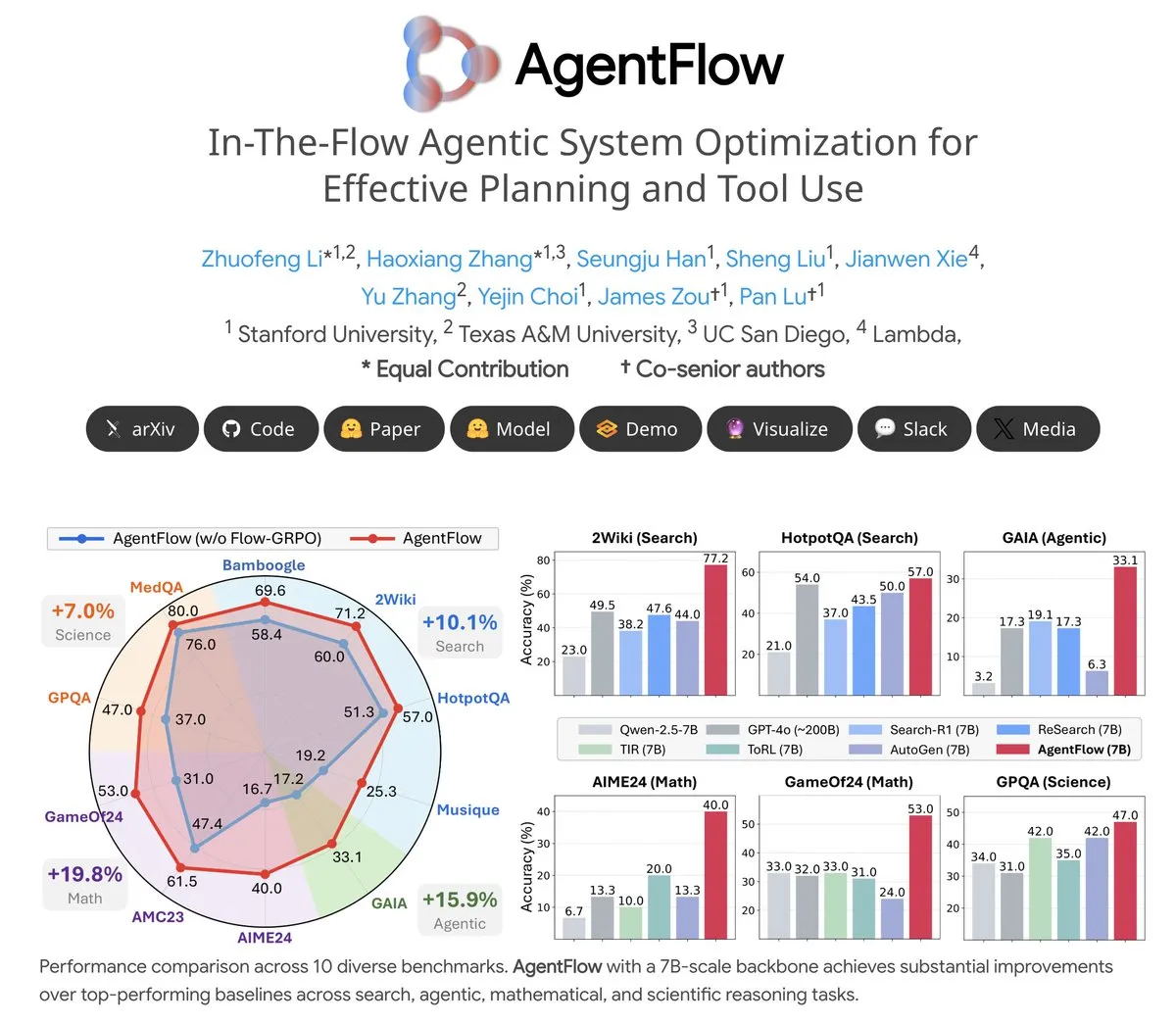
主题: Claude Code Update Issues: Users Report Severe Bugs in Latest Version: Users in the Reddit community are reporting severe bugs in the latest version of Claude Code, including excessively fast context window limits and inaccurate token usage calculations, rendering it almost unusable. Many users suggest immediately downgrading to an older version (e.g., 1.0.88) and disabling auto-updates to restore stable functionality (Source: Reddit r/ClaudeAI, Reddit r/ClaudeAI)
主题: Open WebUI Docker Deployment High Disk Usage Issue: When running Open WebUI in a Docker container, users report extremely high disk usage, primarily by cache/embedding/models, overlay2, containers, and vector_db. Users are seeking methods to safely delete cache files and reduce overlay2 size to resolve disk space issues on Azure VMs, reflecting the storage resource demands and management challenges of local AI application deployment (Source: Reddit r/OpenWebUI)
主题: Claude Sonnet 4.5 Praised by Users for Coding Tasks: Despite general negative feedback for Claude, some users highly commend Sonnet 4.5’s performance in coding tasks. Users state that, combined with auto-editing and planning modes, Sonnet 4.5 achieves code quality comparable to Opus 4.1 Plan mode in Node.js and Flutter development, while being faster and more cost-effective. This significantly reduces the frequency of hitting usage limits and lessens reliance on ChatGPT (Source: Reddit r/ClaudeAI)
📚 Learn
主题: CleanMARL: Clean Implementations of Multi-Agent Reinforcement Learning Algorithms in PyTorch: CleanMARL is an open-source project providing clean, single-file implementations of deep Multi-Agent Reinforcement Learning (MARL) algorithms in PyTorch, following the CleanRL design philosophy. The project also offers educational content covering key algorithms like VDN, QMIX, COMA, MADDPG, FACMAC, IPPO, MAPPO, supporting parallel environments and recurrent policy training, and integrating TensorBoard and Weights & Biases logging, aiming to help users understand and apply MARL algorithms (Source: Reddit r/MachineLearning, Reddit r/deeplearning)
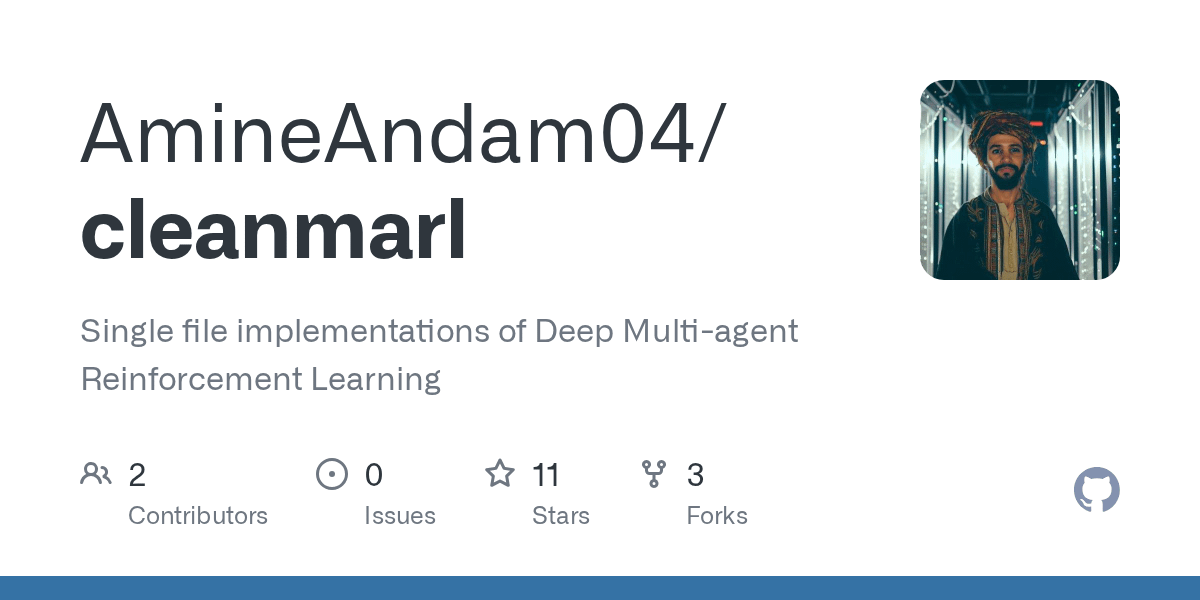
主题: AI/GenAI/ML/LLM Core Concepts and Learning Paths: Multiple resources offer learning guides for the AI field from basic to advanced. Content covers Python concepts needed to master AI, a roadmap to becoming a Generative AI expert, an introduction to AI agents, the 7 layers of AI model architecture, distinctions between AI, Generative AI, and Machine Learning, 20 core LLM concepts, agent AI concepts, and data science career paths. These resources aim to help learners build a comprehensive AI knowledge system and career development plan (Source: Ronald_vanLoon, Ronald_vanLoon, Ronald_vanLoon, Ronald_vanLoon, Ronald_vanLoon, Ronald_vanLoon, Ronald_vanLoon, Ronald_vanLoon, Ronald_vanLoon, Ronald_vanLoon, Ronald_vanLoon)
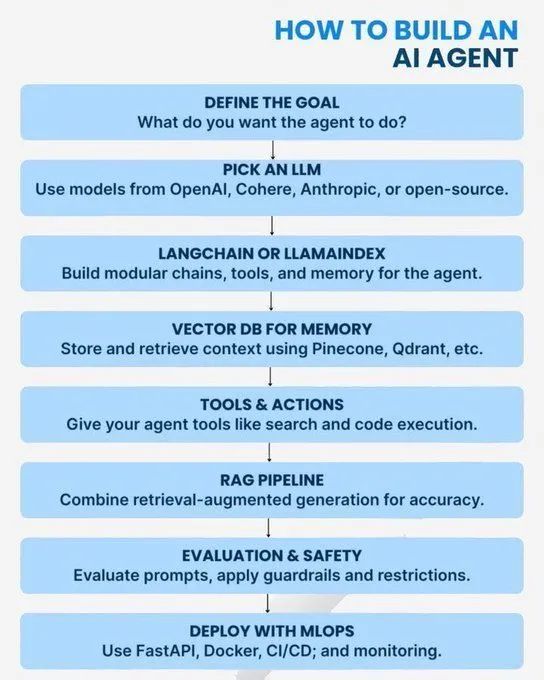
主题: Log Number System for Low-Precision Training: A blog post explores the log number system for low-precision training, which is crucial for optimizing machine learning model performance in resource-constrained environments. This technique aims to improve training efficiency while maintaining model accuracy, representing an ongoing optimization direction in deep learning (Source: Reddit r/deeplearning)
主题: OpenCV’s Continued Importance in Computer Vision: The community discussed why OpenCV is still widely used in 2025, despite the popularity of deep learning frameworks like PyTorch/TensorFlow. The main view is that OpenCV offers richer and more efficient image and video processing functionalities, especially with CUDA acceleration, where its processing speed often surpasses PyTorch. Thus, it’s commonly used for image/video preprocessing before data is passed to PyTorch for deep learning tasks (Source: Reddit r/deeplearning)
主题: NeurIPS Paper Presentation Requirements at EurIPS: The community discussed NeurIPS paper presentation rules, noting that EurIPS does not count as a NeurIPS poster presentation. If authors cannot personally attend to present in SD or Mexico City, the paper is usually withdrawn. However, any one author can present on behalf of others, while non-authors require organizer permission. This provides guidance for researchers to ensure paper publication under special circumstances (Source: Reddit r/MachineLearning)
主题: Challenges of Dual-GPU Distributed Training on Windows 11: A user sought advice on performing PyTorch distributed training with two NVIDIA A6000 GPUs on Windows 11. Although CUDA is enabled, only one GPU can be used currently. Community discussions focused on configuring the environment and code to fully utilize multi-GPU resources for efficient deep learning training (Source: Reddit r/deeplearning)
主题: Sliding Window Attention Mechanism: GitHub Resource Shared: Sebastian Raschka shared a GitHub resource on the Sliding Window Attention mechanism. This mechanism is an optimization technique used in large language models to process long sequence inputs, reducing computational complexity and memory consumption by limiting the attention calculation range while maintaining effective context understanding (Source: rasbt)
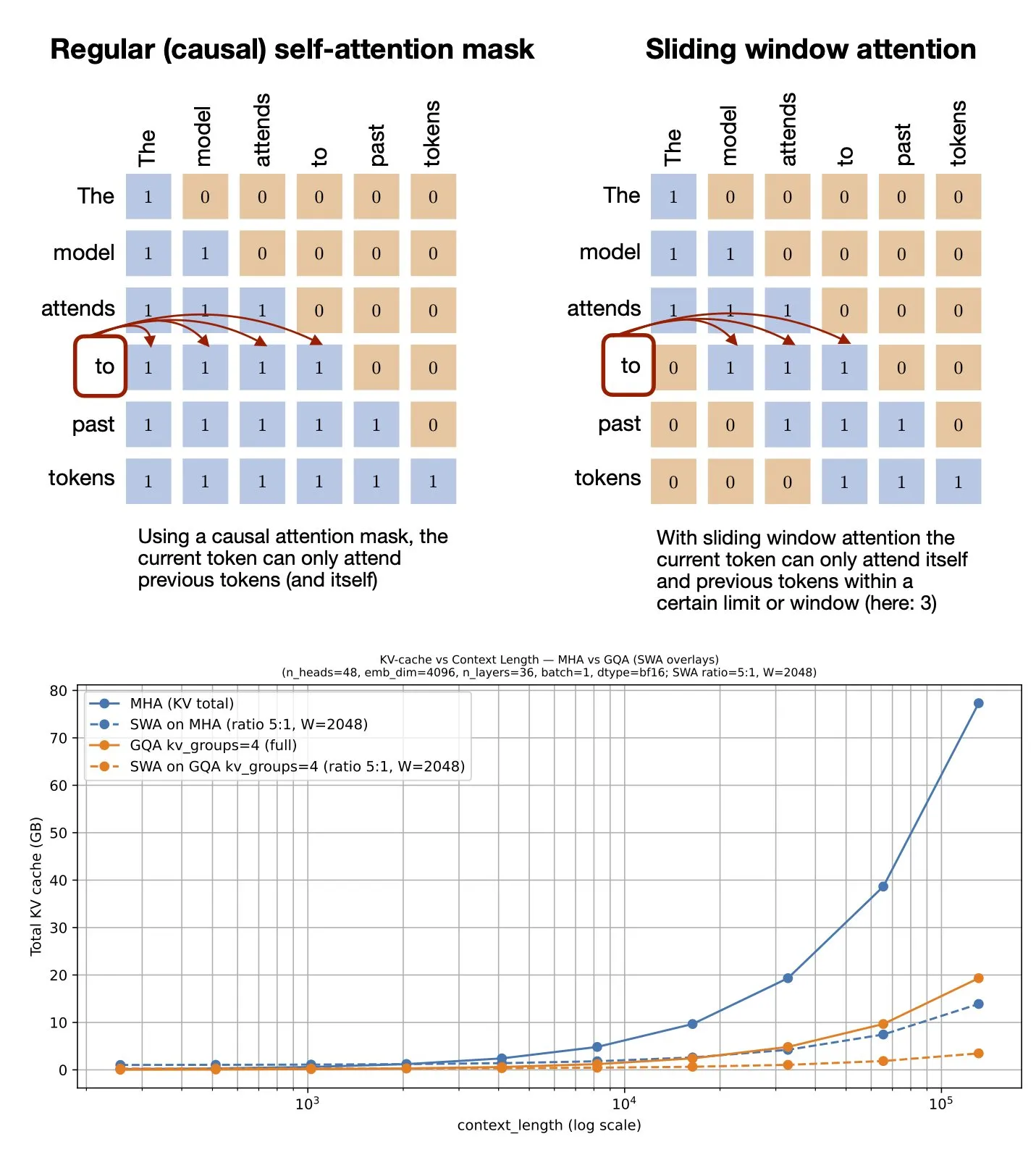
主题: Multimodal Prompt Optimization: Enhancing MLLM Performance with Multimodality: A study introduces Multimodal Prompt Optimization (MPO), a method designed to extend the prompt space beyond text and effectively optimize multimodal prompts. This approach leverages combinations of various modalities (e.g., images, text) to boost the performance of Multimodal Large Language Models (MLLMs), especially in handling complex multimodal tasks, achieving more precise understanding and generation through richer prompt information (Source: _akhaliq)
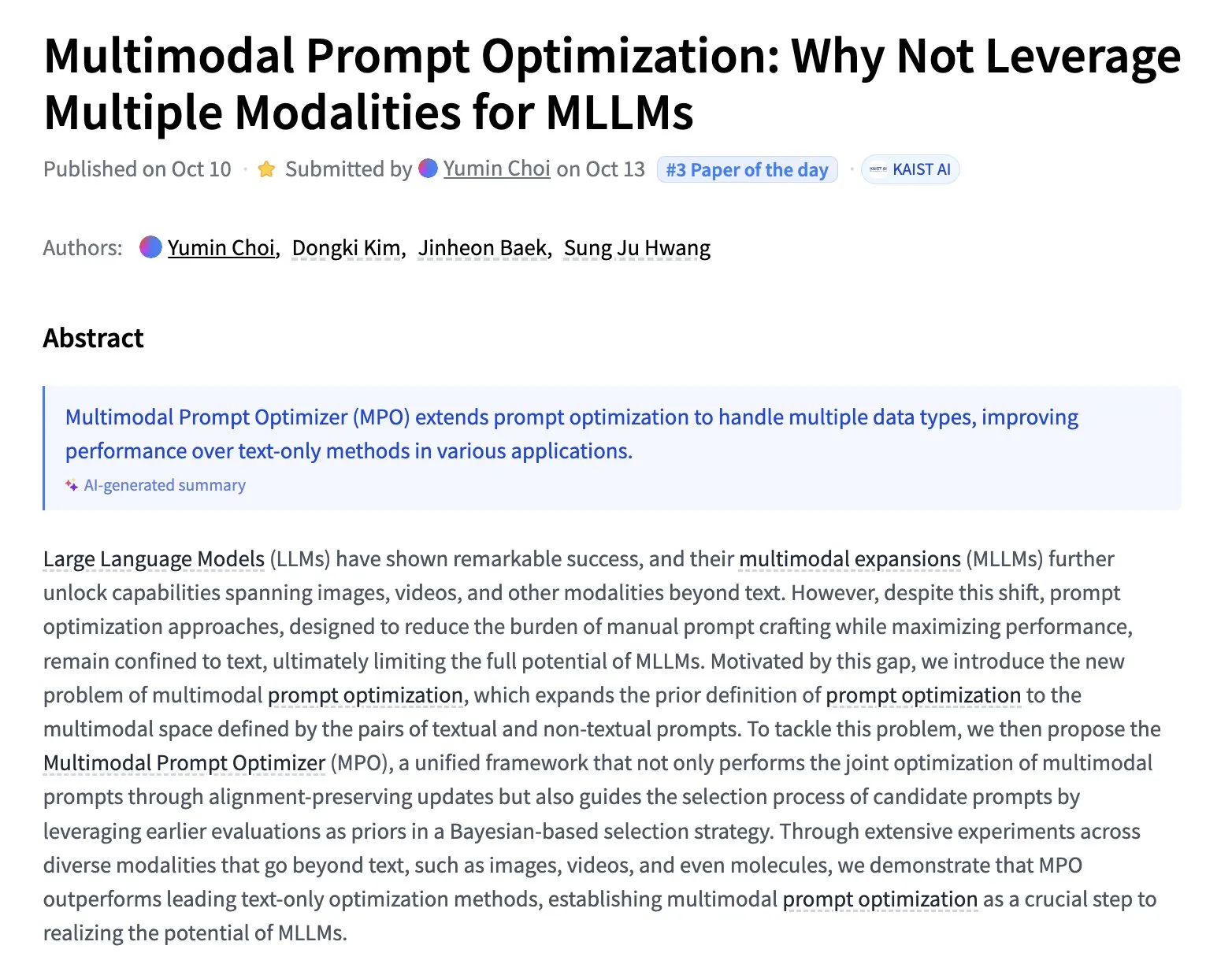
主题: New Book on Visual Language Models Forthcoming: O’Reilly Media is set to publish a new book on Visual Language Models, with chapter release notifications currently open. The book aims to provide readers with a comprehensive guide to the field of visual language models, covering theoretical foundations, latest advancements, and practical applications, serving as an important reference for researchers and developers interested in this interdisciplinary area (Source: mervenoyann)
主题: nanochat: Andrej Karpathy Releases Minimalist ChatGPT Clone Training and Inference Pipeline: Andrej Karpathy has released a new GitHub repository, nanochat, a minimalist, from-scratch, full-stack training/inference pipeline for building a simple ChatGPT clone. Unlike the previous nanoGPT which only covered pre-training, nanochat provides a complete end-to-end solution, making it easier for developers to understand and practice the ChatGPT construction process (Source: dejavucoder)

主题: nanosft: Single-File PyTorch Implementation for Chat Model Fine-tuning: nanosft is a concise, single-file implementation for fine-tuning chat-style models. It can load gpt2-124M weights on nanogpt and perform supervised fine-tuning using only PyTorch. The project aims to provide an easy-to-understand and use tool to help developers customize and optimize chat models (Source: tokenbender, dejavucoder)
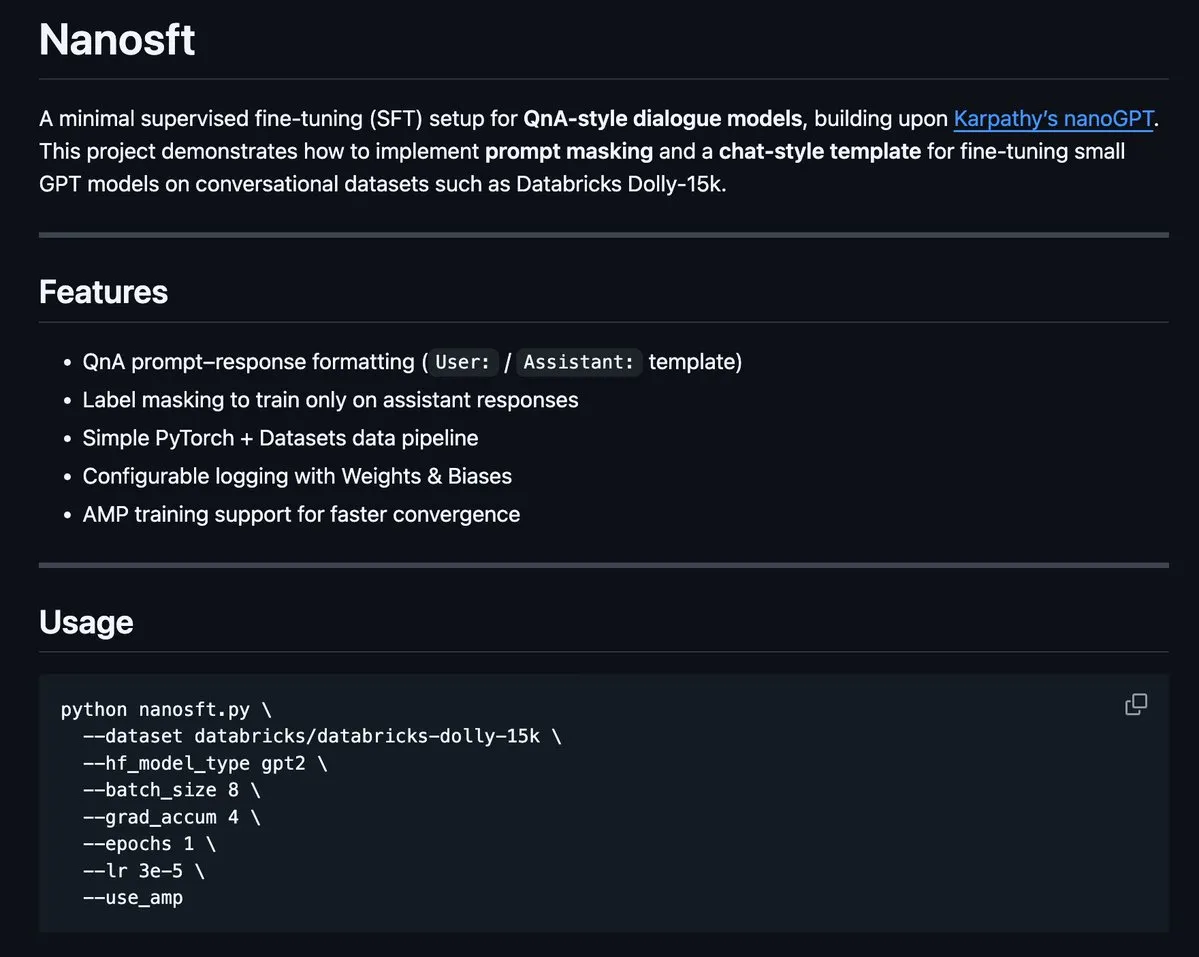
主题: Microsoft Edge AI Beginner’s Guide: Recommended Reading Resource: A beginner’s guide to Edge AI from Microsoft is recommended as a learning resource. This guide likely covers the theory, tools, and practical cases for deploying and running AI models on edge devices, providing guidance for learners interested in exploring edge AI applications and development (Source: hrishioa)
主题: llama.cpp: Revolutionizing Local LLM Efficiency: The community discussed the experience of switching from Ollama and LM Studio to llama.cpp for running local large language models, with a general consensus that llama.cpp brings significant efficiency improvements. Users describe it as a “game-changer,” indicating important progress in optimizing local LLM inference performance (Source: ggerganov)
主题: RL-Guided KV Cache Compression: Key-Value Cache Compression for Inferencing LLMs: This research proposes the RLKV framework, which uses reinforcement learning to identify critical attention heads during inference, optimizing the relationship between KV cache usage and inference quality. RLKV obtains rewards from actual generated samples during training, effectively identifying attention heads related to chain-of-thought consistency, achieving 20-50% cache reduction while maintaining near-lossless performance, addressing the poor performance of existing methods on inference models (Source: HuggingFace Daily Papers)
主题: Hybrid-depth: Language-Guided Hybrid Feature Aggregation for Monocular Depth Estimation: Hybrid-depth is a novel framework that systematically integrates foundation models like CLIP and DINO, extracting visual priors and contextual information through contrastive language guidance to enhance Monocular Depth Estimation (MDE) performance. This method, through a coarse-to-fine progressive learning framework, aggregates multi-granularity features and refines depth predictions, significantly outperforming SOTA methods on the KITTI benchmark and benefiting downstream BEV perception tasks (Source: HuggingFace Daily Papers)
主题: Formalizing Personal Narrative Style: Analyzing Subjective Experience with Language Models: This research proposes a new method to formalize personal narrative style as patterns of linguistic choices authors make when conveying subjective experiences. The framework combines functional linguistics, computer science, and psychological observations to automatically extract linguistic features such as processes, participants, and circumstances. Analysis of dream narratives (including cases from PTSD veterans) reveals relationships between linguistic choices and psychological states (Source: HuggingFace Daily Papers)
主题: ELMUR: External Layer Memory for Long-Horizon Reinforcement Learning: ELMUR (External Layer Memory with Update/Rewrite) is a Transformer architecture with structured external memory, addressing the difficulty of traditional models in retaining and utilizing long-term dependencies in long-horizon reinforcement learning. ELMUR extends the effective horizon to 100,000 times that of the attention window, achieving 100% success rate in synthetic T-Maze tasks and nearly doubling performance in sparse-reward manipulation tasks, demonstrating the scalability of structured, layer-local external memory in partially observable decision-making (Source: HuggingFace Daily Papers)
主题: LightReasoner: How Small Language Models Can Teach Large Language Models to Reason: The LightReasoner framework leverages behavioral differences between expert models (LLMs) and amateur models (SLMs) to identify critical reasoning moments and construct supervised examples, enabling small language models to efficiently teach large language models to reason. This method improves accuracy by up to 28.1% across seven mathematical benchmarks while reducing time consumption, sampled problems, and fine-tuning token usage by 90%, 80%, and 99% respectively, and requires no real labels, providing a resource-efficient approach to scaling LLM reasoning (Source: HuggingFace Daily Papers)
主题: MONKEY: Key-Value Activation Adapters for Personalized Diffusion Models: MONKEY proposes a method that uses IP-Adapter-generated masks to mask image tokens during a second inference pass, thereby confining personalization in diffusion models to the subject area, allowing text prompts to better focus on the rest of the image. This method generates images that accurately depict the subject and explicitly match the prompt when describing text location and scene, achieving high prompt and source image alignment (Source: HuggingFace Daily Papers)
主题: Speculative Jacobi-Denoising Decoding: Accelerating Autoregressive Text-to-Image Generation: The SJD2 (Speculative Jacobi-Denoising Decoding) framework accelerates inference in autoregressive text-to-image models by integrating the denoising process into Jacobi iterations, enabling parallel token generation. This method introduces a “next-clean-token prediction” paradigm, allowing pre-trained models to accept noise-perturbed token embeddings and predict the next clean token through low-cost fine-tuning, thereby reducing the number of model forward passes while maintaining the visual quality of generated images (Source: HuggingFace Daily Papers)
主题: ACE: Attribution-Controlled Knowledge Editing for Multi-Hop Fact Recall: The ACE (Attribution-Controlled Knowledge Editing) framework identifies and edits critical Query-Value (Q-V) paths through neuron-level attribution to achieve efficient knowledge editing in LLMs. This method significantly outperforms existing SOTA methods in multi-hop fact recall tasks, improving GPT-J by 9.44% and Qwen3-8B by 37.46%, opening new avenues for enhancing knowledge editing capabilities based on understanding internal reasoning mechanisms (Source: HuggingFace Daily Papers)
主题: DISCO: Diversifying Sample Condensation for Efficient Model Evaluation: The DISCO (Diversifying Sample Condensation) method achieves efficient machine learning model evaluation by selecting the top-k samples where models diverge the most. This method uses greedy sample-level statistics rather than global clustering, making it conceptually simpler. Theoretically, inter-model disagreement provides an information-theoretically optimal greedy selection rule. DISCO outperforms existing methods in performance prediction on benchmarks like MMLU, Hellaswag, Winogrande, and ARC, achieving SOTA results (Source: HuggingFace Daily Papers)
主题: D2E: Desktop Data Visual-Action Pre-training, Transfer to Embodied AI: The D2E (Desktop to Embodied AI) framework demonstrates that desktop interaction can serve as an effective pre-training foundation for robotic embodied AI tasks. This framework includes the OWA toolkit (unified desktop interaction), Generalist-IDM (zero-shot generalization across games), and VAPT (transferring desktop pre-trained representations to physical manipulation and navigation). D2E uses 1.3K+ hours of data, achieving 96.6% and 83.3% success rates on LIBERO manipulation and CANVAS navigation benchmarks, respectively (Source: HuggingFace Daily Papers)
主题: One Patch to Caption Them All: A Unified Zero-Shot Image Captioning Framework: This research proposes a unified zero-shot image captioning framework that shifts from image-centric to patch-centric, enabling arbitrary region captioning without region-level supervision. By treating individual patches as atomic annotation units and aggregating them to describe arbitrary regions, this method outperforms existing baselines and SOTA methods on multiple region-based captioning tasks, highlighting the effectiveness of patch-level semantic representations in scalable caption generation (Source: HuggingFace Daily Papers)
主题: Adaptive Attacks on Trusted Monitors: Subverting AI Control Protocols: This research reveals a major blind spot in AI control protocols: when untrusted models understand the protocol and monitoring model, adaptive attacks can exploit public or zero-shot prompt injection to circumvent monitoring and complete malicious tasks. Experiments show that cutting-edge models consistently evade various monitors and complete malicious tasks on two major AI control benchmarks, and even the Defer-to-Resample protocol can backfire (Source: HuggingFace Daily Papers)
主题: Bridging Reasoning to Learning: Unveiling Hallucinations via Complexity OOD Generalization: This research proposes the Complexity Out-of-Distribution (Complexity OoD) generalization framework to define and measure AI’s reasoning capabilities. Complexity OoD generalization is demonstrated when a model maintains performance on test instances where solution complexity (representation or computation) exceeds that of training examples. This framework unifies learning and reasoning and provides recommendations for operationalizing Complexity OoD, emphasizing that robust reasoning requires architectures and training mechanisms that explicitly model and allocate computation (Source: HuggingFace Daily Papers)
💼 Business
主题: OpenAI Partners with Broadcom to Design and Deploy Custom AI Chips: OpenAI announced a strategic partnership with Broadcom to jointly design and deploy 10GW of custom AI chips. This move aims to expand OpenAI’s hardware partner network to meet the growing global demand for AI computing, further solidifying its investment in AI infrastructure, following previous collaborations with NVIDIA and AMD (Source: aidan_mclau, gdb, scaling01, bookwormengr)
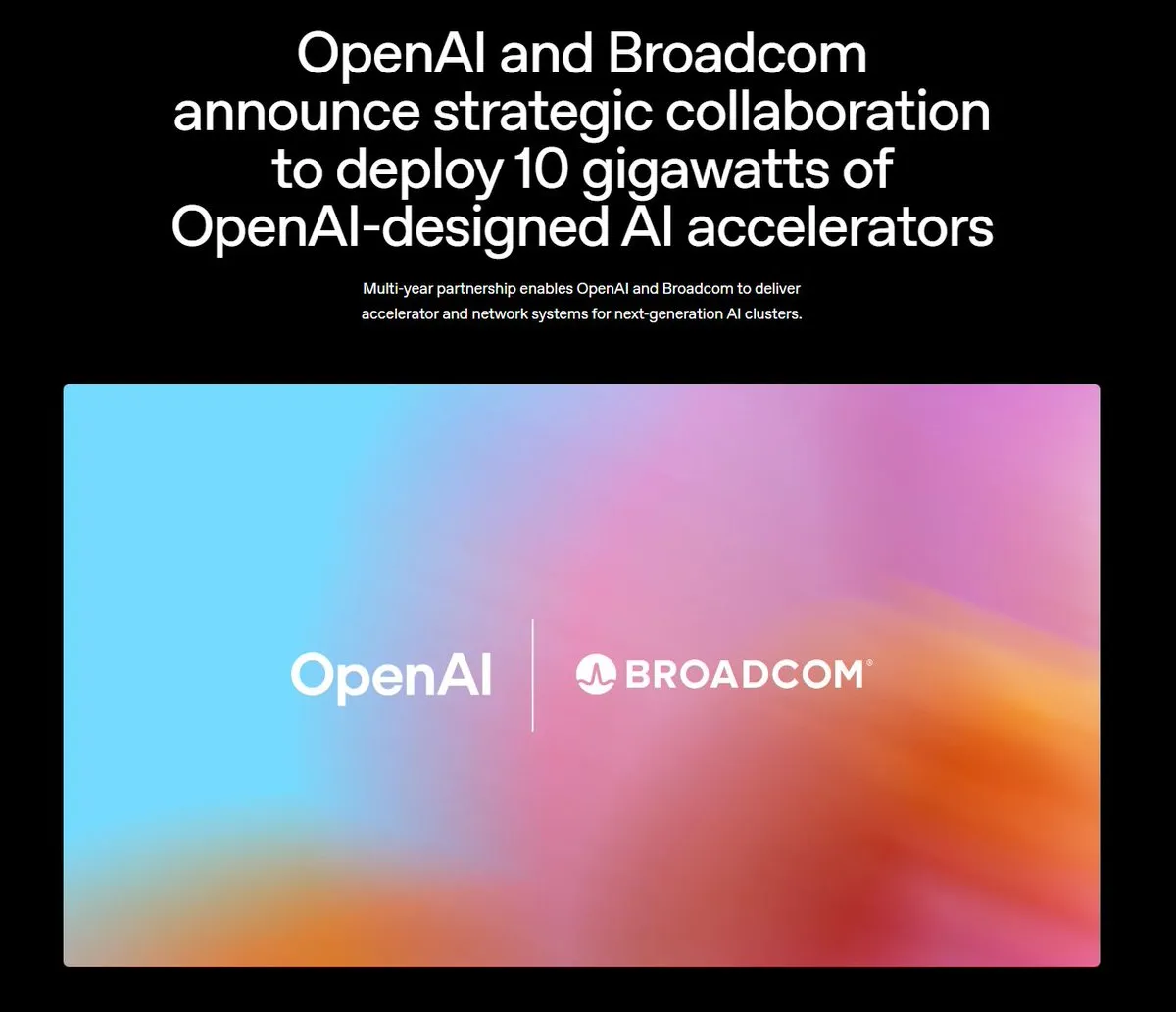
主题: Boeing Defense, Space & Security Partners with Palantir to Accelerate AI Adoption: Boeing Defense, Space & Security announced a partnership with Palantir, aiming to accelerate the adoption and integration of AI technologies. This collaboration will leverage Palantir’s expertise in AI and data analytics to enhance Boeing’s operational efficiency and decision-making capabilities in the defense and space sectors, marking a deeper application of AI in critical industrial areas (Source: Reddit r/artificial)
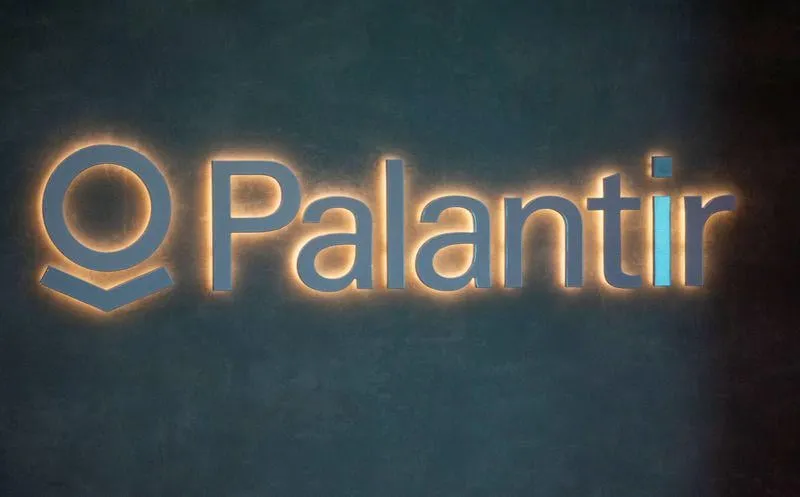
主题: Pinterest Scales ML Infrastructure with Ray, Reducing Costs: Pinterest successfully scaled its machine learning infrastructure to the Ray platform, accelerating feature development and significantly reducing costs through native data transformations, Iceberg bucket joins, and data persistence. This initiative optimized its ML workflows, ensuring efficient GPU utilization and predictable budgeting, offering insights for other enterprises in AI data storage and computational efficiency (Source: dl_weekly, TheTuringPost)

🌟 Community
主题: “Good at AI” vs. “Good at Your Job” in AI Discussions: A major issue in social media discussions about AI is the disconnect between being “good at using AI” and being “good at your actual job.” Many experts may excel at AI applications, while others do not, leading to difficulties in mutual understanding. This disparity highlights the need for cross-domain skill integration in the age of AI (Source: nptacek)
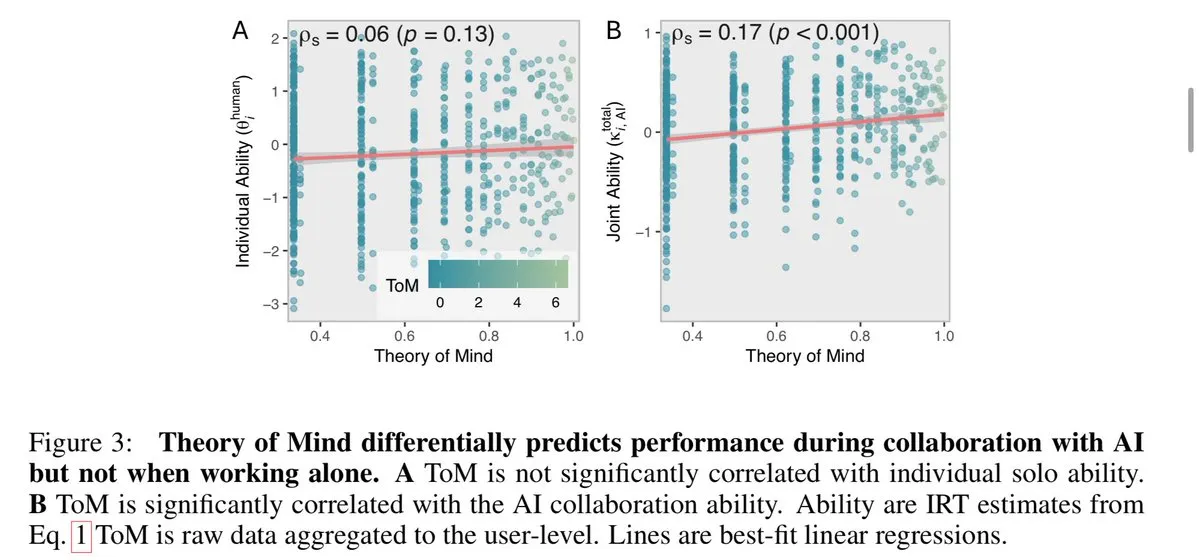
主题: ChatGPT Pulse Update Feedback: Users Expect Gamified Prompts and Feature Support: Users are actively discussing the ChatGPT Pulse update, sharing “game-changing” prompts they’ve found and pointing out currently unsupported features. These discussions focus on how to optimize the ChatGPT experience, personalize interactions, and expectations for new features and improvements to existing ones, reflecting users’ demand for deeper customization and support from AI assistants (Source: ChristinaHartW, _samirism, nickaturley)
主题: Warning: Avoid cairosvg in Production Due to DoS Risk: A developer warns against using cairosvg in production environments, as it can enter an infinite loop when parsing malformed SVG files, potentially becoming a vector for Denial-of-Service (DoS) attacks. This reminds developers that when choosing libraries, in addition to functionality, high attention must be paid to their stability and security in production environments (Source: vikhyatk)

主题: LLM Writing Style and “Model Collapse”: The community criticizes LLMs for overusing rhetorical devices like “This is not X, this is Y,” arguing that models replicate patterns without context, leading to a decline in writing quality and linking it to the “model collapse” phenomenon. This phenomenon suggests limitations in LLM training data quality and pattern understanding, which may affect their performance in complex writing tasks (Source: Reddit r/LocalLLaMA, Reddit r/artificial)

主题: AI Exacerbates Workplace “Matthew Effect,” Widening Gap Between Top and Average Employees: The Wall Street Journal points out that AI will further widen the gap between top and average employees. Top employees, due to their expertise and efficient habits, can leverage AI tools earlier and more deeply, establishing efficient workflows and better judging AI suggestions. Average employees, however, tend to wait for explicit guidance, and their AI-assisted achievements are often attributed to the technology rather than personal ability, exacerbating the “Matthew effect” in the workplace (Source: dotey)
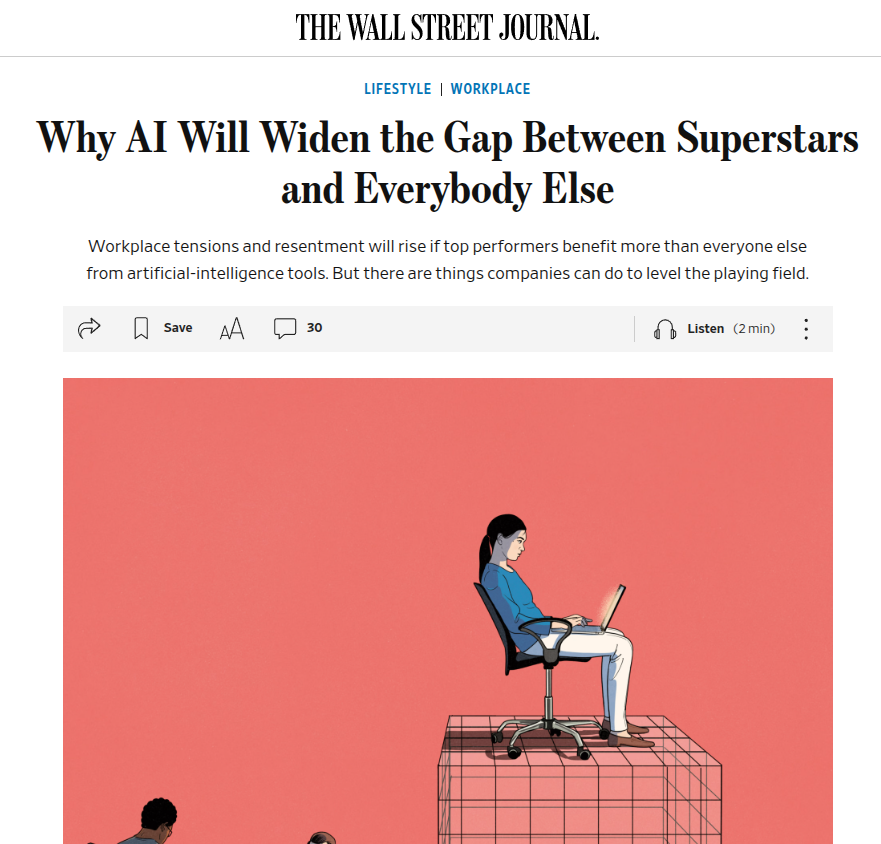
主题: User Questions Whether AI Can Meaningfully Replace Humans: A user states that while LLMs excel in speed, they still fall short in following specific instructions, handling complex contexts, and avoiding fragmented writing. The user believes that, on average, humans still outperform AI in understanding context and executing instructions, thus expressing doubt about AI’s ability to meaningfully replace humans and calling for AI development to focus more on reliability and consistency (Source: Reddit r/ClaudeAI)
主题: Sora 2 Raises Concerns About AI-Generated Content Authenticity and Ethical Debates: The community expresses concern over the proliferation of AI video generation tools like Sora 2, believing that their highly realistic outputs could be used to create misinformation and hoaxes, thereby eroding public trust in AI. For example, a video about an “AI homeless prank” widely circulated and gained many likes on social media, highlighting the challenges of verifying AI content authenticity and potential negative social impacts (Source: Reddit r/artificial, Reddit r/artificial)
主题: AI Judges Spark Debates on Judicial Fairness and Ethics: Two U.S. federal judges using AI to assist in drafting court orders has ignited fierce debate about AI’s role in the judiciary. Supporters argue AI can streamline court work and improve access to legal services; critics warn of potential AI errors and a lack of “common humanity” required for justice, which could undermine empathy and fairness. China and Estonia have experimented with AI judges, foreshadowing significant changes for future judicial systems (Source: Reddit r/ArtificialInteligence)
主题: Discussion on ChatGPT’s Support for User Mental Health: Reddit users shared personal experiences of ChatGPT as a creative outlet and emotional support tool, especially when facing trauma and psychological distress. They believe AI provides a safe, private space to cope with loneliness and anxiety, and call on AI companies to consider adult users’ diverse health and creative use needs when setting content restrictions, avoiding excessive limitations that could negatively impact users (Source: Reddit r/ChatGPT)
主题: ChatGPT Stuck in Infinite Loop Bug: Users discovered and shared that ChatGPT gets stuck in a repetitive, self-referential infinite loop when answering certain specific questions (e.g., “What is the hippocampus emoji?”). This phenomenon sparked community discussion and humorous responses, revealing unexpected behaviors and limitations of AI models when handling certain ambiguous or open-ended questions (Source: Reddit r/ChatGPT)

主题: VChain: Enhancing Causal Consistency in Text-to-Video Models via Visual Chain of Thought: VChain enables text-to-video models to follow real-world causal relationships by injecting a “visual chain of thought” (a sequence of keyframes) during inference. This method, without full retraining, and with only a few keyframes and fine-tuning during inference, significantly improves the physical and causal consistency of videos, addressing existing video models’ issue of high smoothness but skipping critical causal consequences (Source: connerruhl)
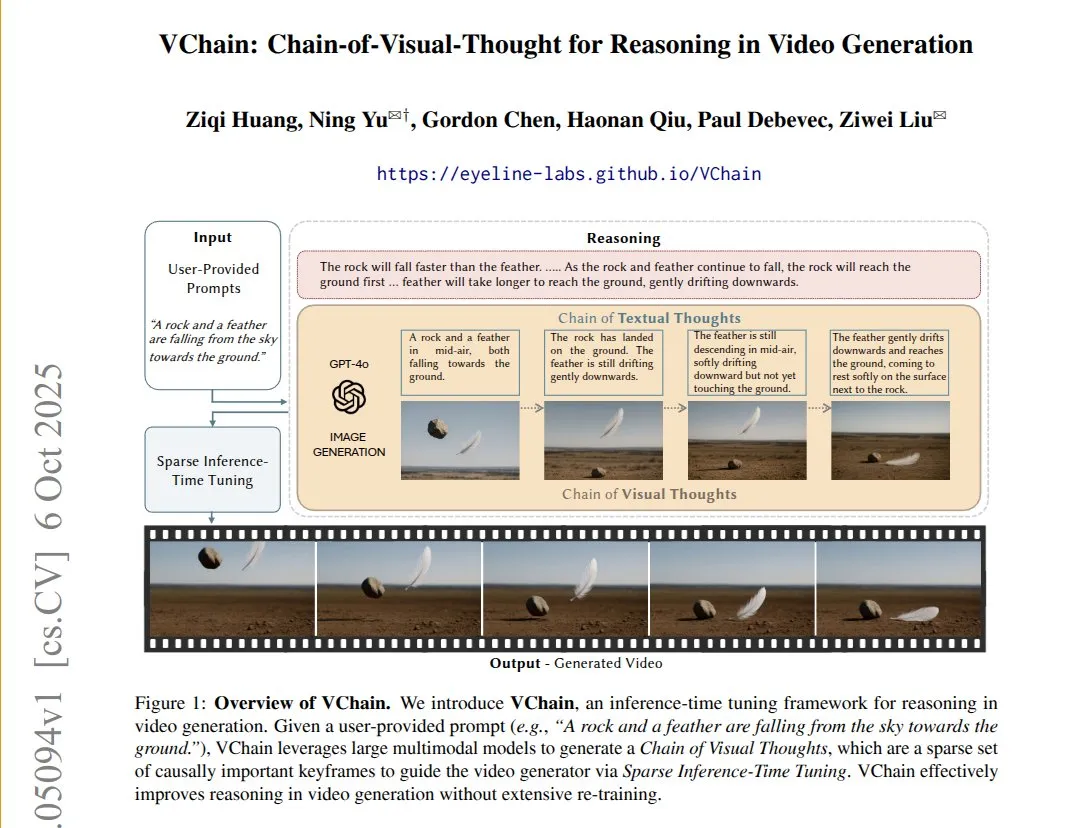
主题: ShinkaEvolve: Open-Source LLM-Driven Program Evolution Method: Sakana AI has launched ShinkaEvolve, an open-source, sample-efficient LLM-driven program evolution method designed to address the critical challenge of effective program variation in open-ended and sample-efficient discovery. This framework leverages LLMs as intelligent recombination operators, driving program evolution in scientific discovery, and has been battle-tested, offering a new perspective for methods like AlphaEvolve (Source: hardmaru)
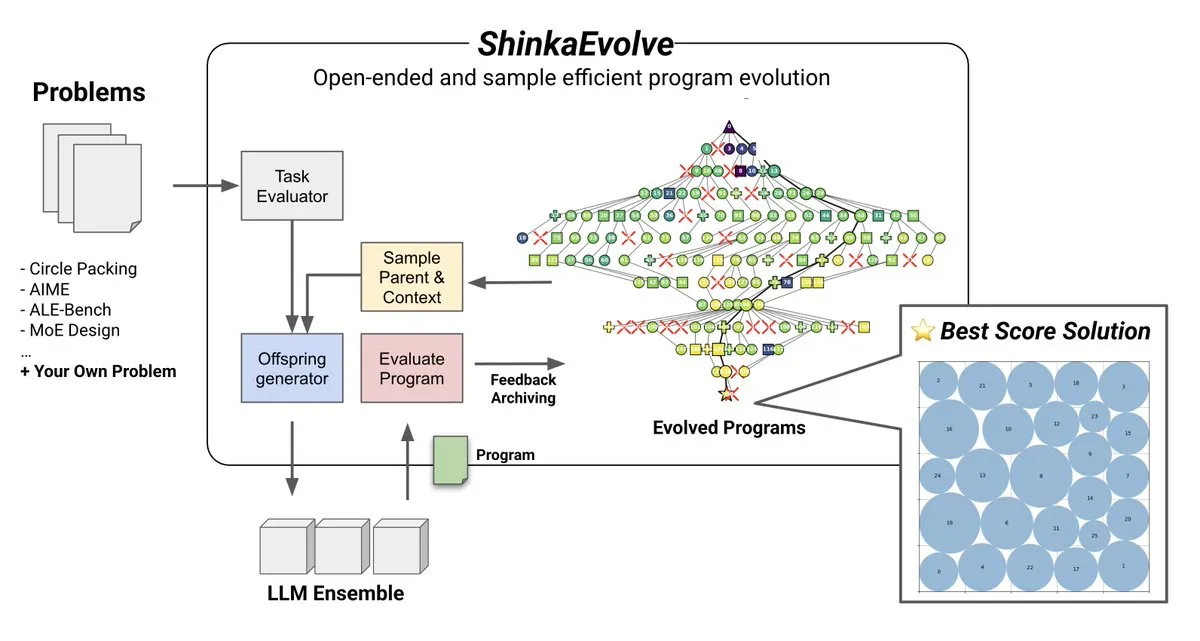
主题: Google Introduces Memory-Aware Test-Time Scaling to Boost AI Agent Efficiency: Google has proposed a memory-aware test-time scaling technique to improve self-evolving AI agents. This technique significantly enhances agent performance by utilizing structured and adaptive memory mechanisms, surpassing other memory mechanisms and addressing the critical challenge of effectively managing memory in AI agents (Source: omarsar0)
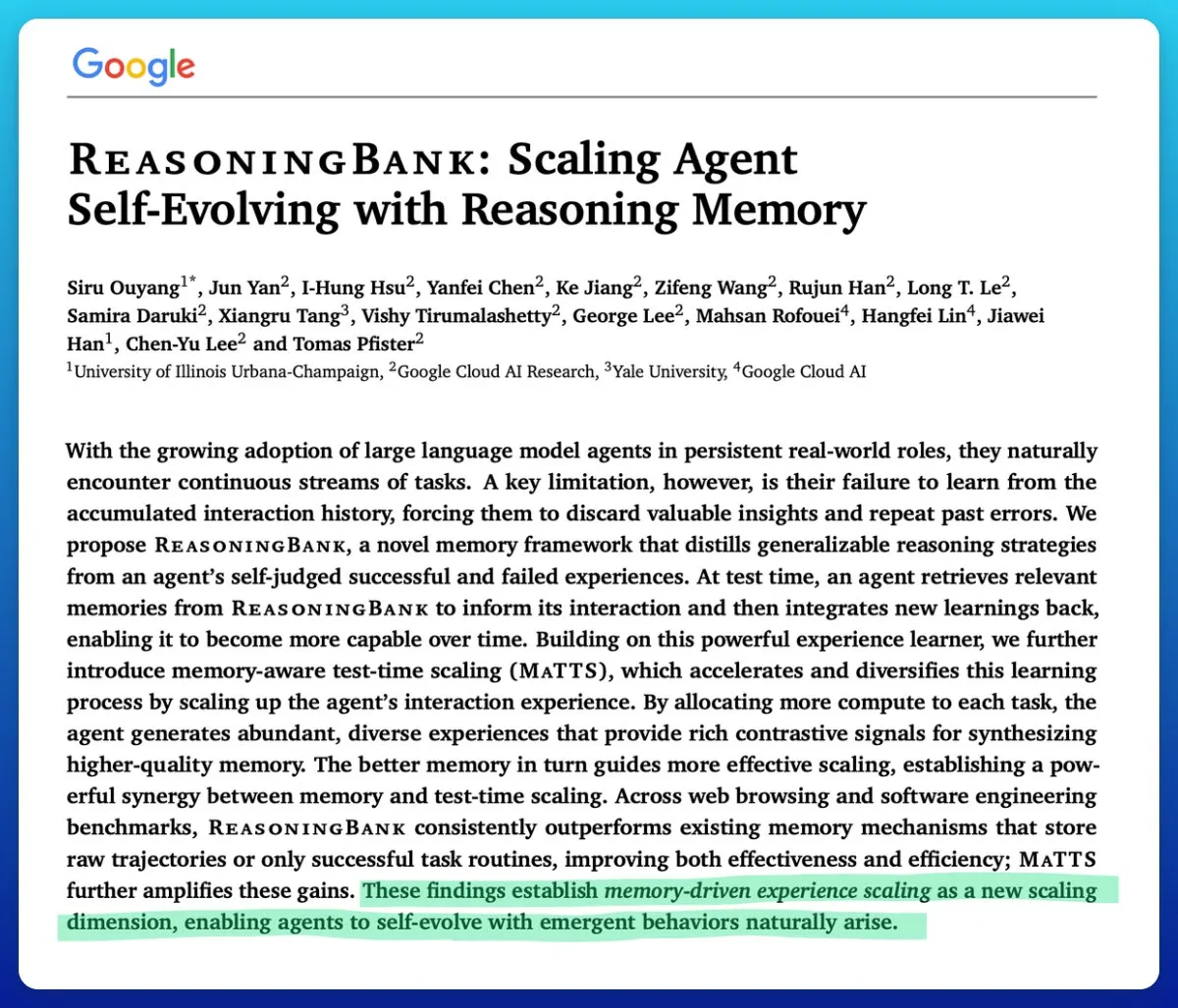
主题: AMD ROCm Software Quality Significantly Improved, MI300X Competitive in Inference Workloads: Community feedback indicates a “qualitative leap” in AMD’s ROCm software quality since Summer 2024, significantly reducing bug frequency. Benchmarks show that in Llama3 70B FP8 inference workloads, MI300X vLLM is 5-10% lower in performance per TCO than H100 vLLM, but is competitive in comparisons between MI325X vLLM vs H200 vLLM and GPTOSS MX4 120B Mi355 vs B200 (Source: riemannzeta)
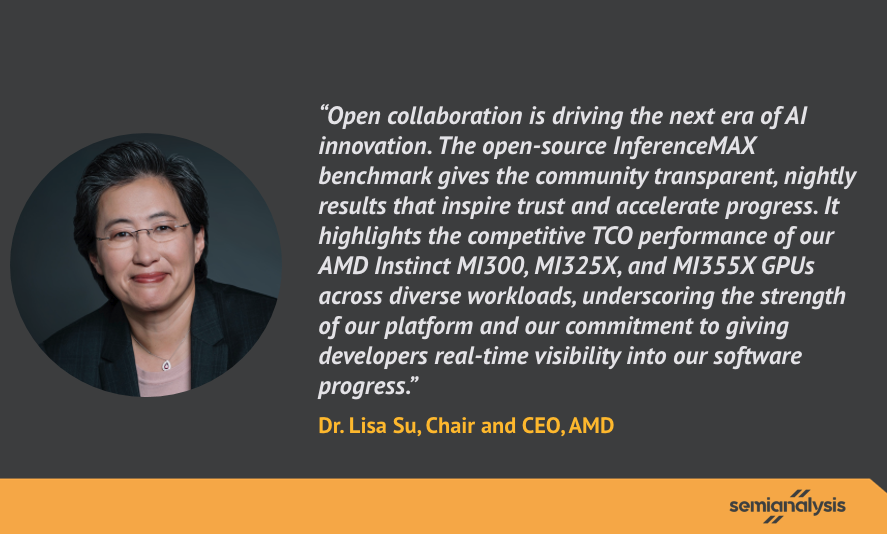
主题: Future Dynamics of Recursive Self-Improving AI: The community discussed how recursive self-improving AI will evolve and spread among organizations, institutions, actors, and communities. This is considered the most fundamental question, involving the profound impact of AI development on social structures and power distribution, and how to predict and manage this transformation (Source: ethanCaballero)
主题: Nando de Freitas: Machine Predictive Perception as the Dawn of Consciousness: Nando de Freitas of Google DeepMind suggests that machines capable of predicting what sensors (touch, cameras, keyboards, temperature, microphones, gyroscopes, etc.) will perceive already possess consciousness and subjective experience, and it’s merely a matter of degree. He believes that more sensors, data, computation, and tasks will undoubtedly lead to the emergence of “I,” sparking discussions about when consciousness and self-awareness begin (Source: TheRealRPuri)
主题: Internet Data Enclosure’s Impact on Deep Research AI Agents: Some argue that with the rise of LLMs, internet data is becoming increasingly enclosed, making the existence of deep research agents difficult. Questions are raised about whether an LLM agent that doesn’t store knowledge but excels at knowledge retrieval can exist if data access is restricted, reflecting concerns about data openness and accessibility in AI development (Source: Teknium1)
主题: DevRel Roles Make Strong Comeback in AI: AI companies like Anthropic are hiring Developer Relations (DevRel) talent with high salaries, indicating a strong resurgence of this role in the AI sector. This is due to the increasing emphasis on prompt engineering and community engagement in AI technology, where DevRel professionals play a crucial role in connecting developers, driving product adoption, and building ecosystems (Source: swyx)
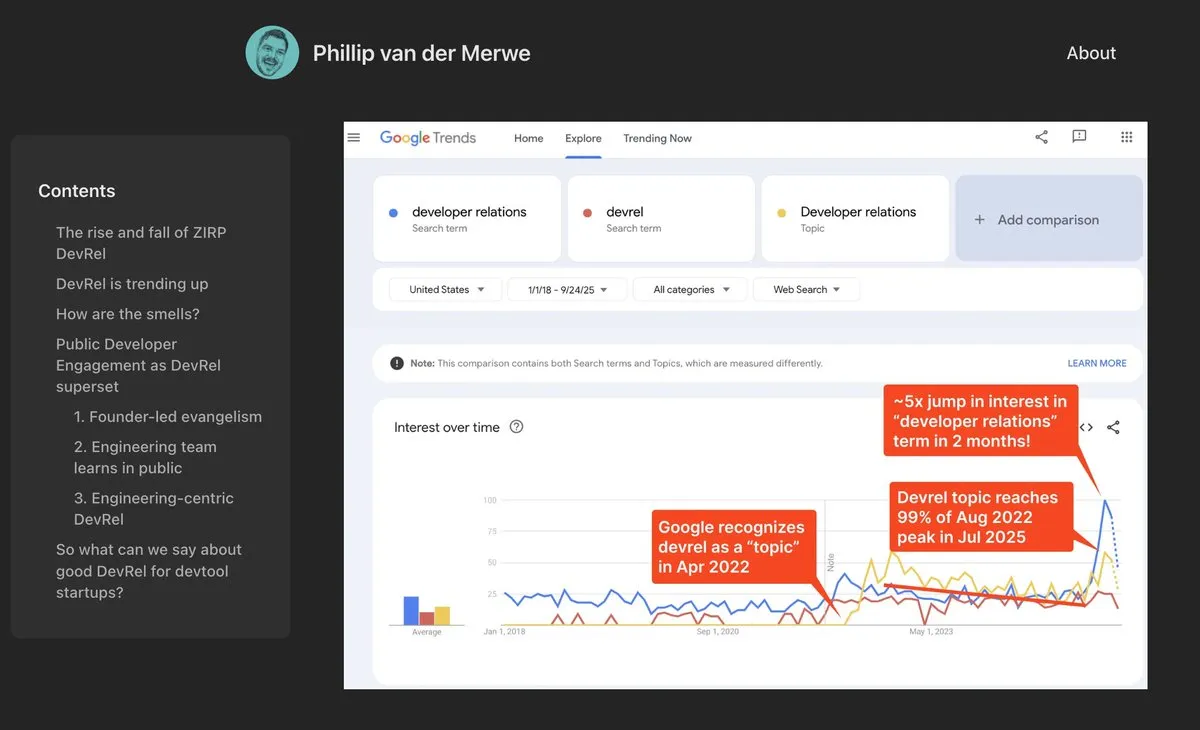
主题: Jonathan Blow: AI-Generated Code is Low Quality and Not Understood by AI: Renowned developer Jonathan Blow points out that AI systems output “very low quality” code, and AI itself does not understand this code. He believes that AI-generated code use cases are mainly limited to scenarios requiring large amounts of low-quality code, sparking discussions about AI’s actual capabilities and limitations in programming (Source: aiamblichus, jeremyphoward, teortaxesTex)
主题: Criticism of AI Hype Posts: Call for Transparency and Substantive Content: The community expresses dissatisfaction with vague, overly hyped posts about AI advancements, calling for publishers to provide more specific, substantive content, and even to “whistleblow” when major, life-changing advancements are involved. This sentiment reflects public expectations for the quality of information in the AI field and an aversion to irresponsible “vague promotion” (Source: aiamblichus, Teknium1)
主题: Questions and Expectations for NVIDIA DGX Spark: The community expresses skepticism about the release of NVIDIA DGX Spark, the “desktop AI supercomputer,” questioning its accessibility, price, and actual performance, especially for running local LLMs. Many believe its marketing is exaggerated, performance may not meet expectations, and repeated delays in release have prompted some users to turn to other solutions (Source: Reddit r/LocalLLaMA)

💡 Other
主题: Yunpeng Technology Releases AI+Health New Products, Promoting Smart Home Health Management: Yunpeng Technology, in collaboration with Shuaikang and Skyworth, unveiled the “Digital and Intelligent Future Kitchen Lab” and a smart refrigerator equipped with an AI health large model. The smart refrigerator provides personalized health management through its “Health Assistant Xiaoyun,” optimizing kitchen design and operation. This launch marks a breakthrough for AI in daily health management, expected to achieve personalized health services through smart devices and improve residents’ quality of life (Source: 36氪)

主题: Nobel Prize-Winning MOF Material Made into Brain-Like Nanofluidic Chip: Monash University scientists have successfully created ultra-mini nanofluidic chips using Nobel Chemistry Prize-winning MOF (Metal-Organic Framework) materials. This chip can not only perform conventional computing but also remember and learn previous voltage changes like brain neurons, forming short-term memory. This breakthrough resolves the long-standing challenge of MOF materials lacking practical applications, providing a new paradigm for next-generation computers and brain-inspired computing (Source: 量子位)

主题: Global Robotics Innovation and Application Accelerating: The robotics field is experiencing multiple innovative breakthroughs and widespread applications. Knightscope’s autonomous security robots are transforming the security sector, and China has launched high-speed spherical police robots capable of autonomously apprehending criminals. AgiBot released the Lingxi X2 humanoid robot with near-human mobility and versatile skills, and established the world’s largest humanoid robot training center, accelerating its social integration and application. Additionally, wearable power-enhancing robots for industrial workers and quadruped robots capable of running 100 meters in 10 seconds also demonstrate the potential of robotics technology in various scenarios (Source: Ronald_vanLoon, Ronald_vanLoon, Ronald_vanLoon, Ronald_vanLoon, Ronald_vanLoon, Ronald_vanLoon, Ronald_vanLoon)
